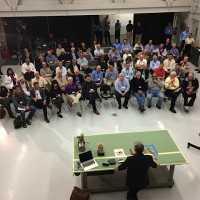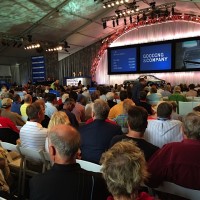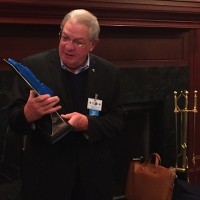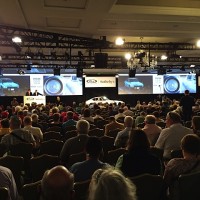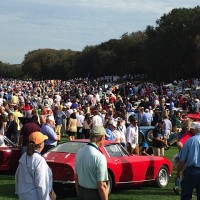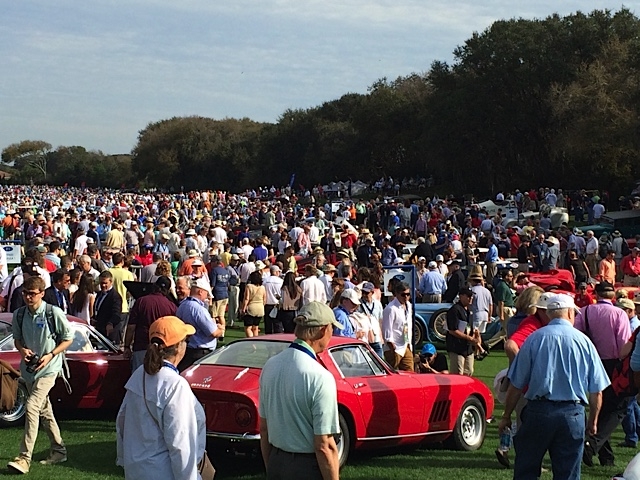
Over the past 12 days, I’ve traveled thousands of miles, seen hundreds of classic cars and shared the joy with countless gearhead enthusiasts.
My trip started with the 8th Biennial Symposium on Connoisseurship and the Collectible Car presented by the Revs Institute. It took place at the Revs Institute for Automotive Research in Naples, FL.
Scholar, collector and frequent SCM contributor Miles Collier founded the Institute. The Symposium brings together about 60 students and a dozen faculty to discuss pressing issues facing car collectors today.
This was my sixth time as a member of the faculty. Teaching with me was a group of noted collectors, including car collector (and Pink Floyd drummer) Nick Mason, Fred Simeone of the Simeone Foundation Automotive Museum, McKeel Hagerty of Hagerty Insurance, historian Doug Nye, restorer Paul Russell, Mark Gessler of the Historic Vehicle Association, David Gooding of Gooding & Company, David Swig of Bonhams, who shared his “under-30-years-old” perspective, and others.
Stanford archaeologist and Revs Program director Michael Shanks offered insights about the relationships between car collecting and other types of historical analysis.
The keynote speaker was Peter Stevens, who designed the McLaren F1. One of the discussions he led included a comparison of the Lotus Elite and the F1.
During the four days of classes, we touched on many aspects of collectability, including what attributes a car needs to be considered “significant.” We also watched cars from the dawn of motoring start and drive, including an 1896 Panhard et Levassor.
We talked about the different types of collecting motivations and different types of collections, from the extremely vertical (collecting nothing but 1965 Mustangs, for example) to hoarding (“It was shiny, and I could afford it”).
Collectible cars were divided into two categories. The first was “contemplative.” These are cars that are not really suitable for driving. An example would be the ex-Briggs Cunningham Maserati Birdcage. The danger of damaging or altering this “historical document” far outweighs whatever might be gained seeing it in motion.
The second category is “experiential.” An example would be the Alfa 8C 2900 in the Revs Collection. The car has already been completely restored, so there are no original surfaces to worry about damaging. Further, there are other 8C Alfas, so you are not putting a sole-surviving example at risk.
For me, the most important issue we discussed had to do with automotive legacy. After we are gone, how do we want our cars taken care of? Do we want our collections to be preserved or broken up and sold? What kind of statement about automotive history do our groupings of cars represent?
I also became more aware of the “story-telling” aspect of my own cars. Because I drive my cars frequently, my cars often have stories attached to them. They include rallies with my son Bradley as navigator and road-trips with my daughter Alex. In some ways the cars are a repository of my family’s history. How should those memories be preserved?
Corvette collector, ACC contributor and good friend Michael Pierce attended the symposium for his second time. At the final session, he turned to me with a smile and said, “My head hurts from all this thinking.” Mind did, too.
There’s simply nothing like this symposium, where collectors from around the world gather to discuss shaping how our culture defines its historical relationship with old cars.
Amelia
Then it was off to Amelia Island, where I was honored to be a judge for the 18th time. This was the 20th anniversary of the Amelia Island Concours d’Elegance, and founder Bill Warner was celebrated throughout the weekend.
In addition to the concours, Bonhams, Gooding & Company, RM Sotheby’s and Hollywood Wheels held auctions. Festivals of Speed had a car show on Saturday, and Amelia hosted its own “Cars and Coffee” at the Ritz.
Alfa guru and longtime friend Matt Jones brought along two surprises for me from his stash of goodies at Re-Originals: an NOS radio block-off plate for my 1967 Giulia Super and a modern reproduction plate for my 1967 Duetto.
I’m looking forward to disposing of the modern radios in both of these cars and bringing them a step closer to the kind of visual presentation I prefer.
The honoree of the weekend was Sir Stirling Moss, who at 85 years old remains full of vim, vigor and vivid recollections of his drives from long ago. I’ve heard him discuss his 1955 record-setting victory in the Mille Miglia many times, and I’m always amazed at his detailed descriptions.
The class I judged was BMW 328s, and chief judge was Mario Theissen, former manager of the BMW F1 team. We judged six 328s. I found that, as always, the more you look at old cars that are very similar, the more they and their owners start to tell their stories. Evaluating the cars and speaking with their owners was a pleasure.
The day ended with the top awards. Best of Show Concours d’Elegance went to Ed Schoenthaler’s 1930 Cord L29 Brooks Stevens Speedster. Best of Show Concours de Sport went to David Sydorick’s 1932 Alfa Romeo 8C 2300 Zagato spider. (Schoenthaler and Sydorick are both SCMers.)
And then, as a special and unexpected treat, I ran into good friend Valentino Balboni, the former Lamborghini test driver. He was as cordial and as enthusiastic as ever. Watching him drive a silver-and-tan Lamborhini 350GT away from the Ritz was a fitting end to the weekend.
Enjoy the photos below and in my Facebook albums here and here. We’ll have much more to say about the Collier Symposium and the Amelia weekend in the next issue of SCM.

